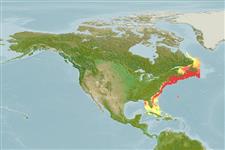Malacostraca |
Decapoda |
Cancridae
Environment: milieu / climate zone / Mức độ sâu / distribution range
Sinh thái học
; Mức độ sâu 0 - 800 m (Tài liệu tham khảo 367). Subtropical, preferred 11°C (Tài liệu tham khảo 107945); 59°N - 20°N, 85°W - 52°W
Western Atlantic: from Newfoundland and Labrador, Canada to Dry Tortugas, Florida and Cuba.
Length at first maturity / Bộ gần gũi / Weight / Age
Chín muồi sinh dục: Lm 8.8 range ? - ? cm Max length : 16.0 cm CW con đực/không giới tính; (Tài liệu tham khảo 101412); Khối lượng cực đại được công bố: 0.00 g
Carapace approximately 2/3 as long as wide, surface coarsely granulate; front (excluding inner orbital angles) with 3 teeth, middle one exceeding others and depressed (flattened dorsoventrally); anterolateral margins divided into 9 quadrangular lobes or teeth with margins minutely denticulate; notches between teeth continued on carapace as short, closed fissures. Pincers stout, nearly as long as second legs, carpus and hand with strong granulose rugae, upper margin of pincers denticulate, carpus with sharp inner dorsal spine. Color: red dorsally, yellow ventrally; back with 2 curved lines of yellowish spots and behind middle, a figure somewhat resembling letter H; legs mottled and reticulated with yellow and red, more or less purplish.
Minimum depth from Ref. 97531. Lives in deep water (Ref. 106868). Occurs from the intertidal zone among rocks to 800 m (Ref. 367). Common in shallow subtidal zone during summer (Ref. 106868). Small to medium-sized individuals are found near shore seasonally (especially in the south), while larger ones only occur in deeper water (Ref. 367). Moves from subtidal into low intertidal with the tide (Ref. 106868). Found in rocky bottom in association with Homarus americanus. Also on rubble and soft substrate (Ref. 97531). Feeds mainly on mollusks, echinoderms, and other invertebrates (Ref. 367). Preyed upon by gulls (Ref. 106868).
Life cycle and mating behavior
Chín muồi sinh dục | Sự tái sinh sản | Đẻ trứng | Eggs | Sự sinh sản | Larvae
Members of the order Decapoda are mostly gonochoric. Mating behavior: Precopulatory courtship ritual is common (through olfactory and tactile cues); usually indirect sperm transfer.
Tavares, M. 2003 True Crabs. pp. 327-352. In Carpenter, K.E. (ed.) The living marine resources of the Western Central Atlantic. Volume1: introdution, molluscs, crustaceans, hagfishes, sharks, batoid fishes, and chimaeras. FAO Species Identification Guide for Fishery Purposes and American Society of Ichthyologists and Herpetologists Special PublicationNo. 5. Rome, FAO. pp. 1-600. (Tài liệu tham khảo 367)
IUCN Red List Status
(Tài liệu tham khảo 130435: Version 2025-1)
CITES status (Tài liệu tham khảo 108899)
Not Evaluated
CMS (Tài liệu tham khảo 116361)
Not Evaluated
Threat to humans
Human uses
Các nghề cá: Tính thương mại
FAO - Các nghề cá: landings | FishSource | Biển chung quanh ta
Các công cụ
Thêm thông tin
PhysiologyThành phần ô-xy
Human RelatedStamps, coins, misc.
Các nguồn internet
Estimates based on models
Preferred temperature
(Ref.
115969): 1.6 - 17.9, mean 6.4 (based on 149 cells).
Fishing Vulnerability
Low vulnerability (10 of 100).
Climate Vulnerability
Low to moderate vulnerability (30 of 100).
Nutrients : Calcium = 109 [35, 184] mg/100g; Iron = 1.59 [1.21, 1.97] mg/100g; Protein = 20.2 [19.2, 21.3] %; Omega3 = 0.285 [0.185, 0.386] g/100g; Selenium = 48.3 [-31.7, 128.3] μg/100g; VitaminA = 0 μg/100g; Zinc = 1.79 [1.17, 2.40] mg/100g (wet weight); based on
nutrient studies.
